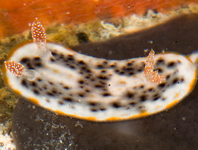Abstract
Pantomorus albosignatus Boheman, 1840 (Entiminae: Naupactini), type species of the genus Pantomorus Schoenherr, 1840, is broadly distributed in Mexico, from Oaxaca and Veracruz to Chihuahua and Coahuila, and is probably related to P. parvulus Sharp 1891 (México: Oaxaca and Veracruz), P. andersoni sp. nov. (México: Guerrero), and P. crinitus (Boheman, 1840) (southern Mexico, El Salvador and Guatemala). The four species are small (5-8 mm), apterous, usually show a characteristic maculation and erect setae on the elytra, short antennae, vestigial to absent humeri, and well-developed, squamose corbels of the metatibiae, and are here referred to as the Pantomorus albosignatus species group. Our study was based on the examination of type material and about 500 specimens from different collections, and provides a dichotomous key, descriptions or redescriptions of the species, habitus photographs, line drawings of female and male genitalia, a map of distribution, new locality records and new plant associations. We propose that Pantomorus nobilis (Boheman 1840) is a new junior subjective synonym of P. crinitus (Boheman, 1840), and we designate lectotypes for the species Pantomorus albosignatus Boheman, P. parvulus Sharp, P. crinitus (Boheman), P. nobilis (Boheman) and P. affinis Sharp, 1891 (the latter is also a junior synonym of P. crinitus). Pantomorus albosignatus usually inhabits Acacia grasslands and cactus deserts of the Mexican Plateau, at higher elevations than remaining species; P. parvulus occurs in cloud forests and tropical deciduous forests of southern Mexico; P. crinitus in open oak pine forests, cloud forests and tropical deciduous forests of southern Mexico, Guatemala and El Salvador; and P. andersoni is endemic to the state of Guerrero, in Acacia-cactus woodlands.
References
Boheman, C.H. (1840) Familia Curculionides. Ordo secundus. Gonatoceri. In: Schoenherr, C.J., Genera et species curculionidum cum synonymia hujus familiae. Vol. 5. Pt .1. & Vol. 6. Pt 1. Fleischer, Lipsiae, Paris, pp. 942–944 & pp. 1–474.
Champion, G.C. (1911) Insecta. Coleoptera. Rhynchophora. Curculionidae. Otiorhynchinae [part “Alatae and supplement to the Thecesterninae and Otiorhynchinae]. In: Sharp, D. & Champion, G.C. (1889–1911), Biologia Centrali Americana, 4 (Part 3), pp. 313–354, 15 pls.
Chevrolat, L.A.A. (1879) Remarques sur diverses espces de Naupactides, groupe de la famille des Curculionides. Bulletin de la Sociét Entomologique de France, 1879, pp. CXXX.
Elias-Costa, A., Rodriguero, M., Lanteri, A.A. & Confalonieri, V.A. (2019) Game of Clones: Is Wolbachia inducing speciation in a weevil with a mixed reproductive mode? Molecular Phylogenetics and Evolution, 133 (2019), 42–53.
https://doi.org/10.1016/j.ympev.2018.12.027
Guzmán, N.V., Lanteri, A.A. & Confalonieri, V.A. (2012) Colonization ability of two invasive weevils with different reproductive modes. Evolutionary Ecology, 26, 1371–1390.
https://doi.org/10.1007/s10682-012-9564-4
Lanteri, A.A. (1995) Systematic revision of Ericydeus Pascoe (Coleoptera: Curculionidae). Entomologica scandinavica, 26 (4), 393–424.
https://doi.org/10.1163/187631295X00071
Lanteri, A.A. & del Río, M.G. (2019) Revision of the species of Phacepholis Horn (Coleoptera: Curculionidae: Entiminae: Naupactini) from Mexico and Central America. The Coleopterists Bulletin, 73 (4), 975–991.
https://doi.org/10.1649/0010-065X-73.4.975
Lanteri, A.A. & Normark, B.B. (1995) Parthenogenesis in the tribe Naupactini (Coleoptera: Curculionidae). Annals of the Entomological Society of America, 88 (6), 722–731.
https://doi.org/10.1093/aesa/88.6.722
Lanteri, A.A. & O’Brien, C.W. (1990) Taxonomic revision and cladistic analysis of Atrichonotus Buchanan (Coleoptera: Curculionidae). Transaction of the American Entomological Society, 116 (3), 697–725.
Marvaldi, A.E., Lanteri, A.A., del Río, M.G. & Oberprieler, R.G. (2014) 3.7.5. Entiminae Schoenherr, 1823. In: Leschen, R.A. & Beutel, R.G. (Eds.), Handbook of Zoology. Coleoptera, Beetles. Morphology and Systematics. Vol. 3. De Gruyter, Berlin and Boston, Massachusetts, pp. 503–522.
O’Brien, C.W. & Wibmer, G.J. (1982) Annotated checklist of the weevils (Curculionidae sensu lato) of North America, Central America, and the West Indies (Coleoptera: Curculionoidea). Memoirs of the American Entomological Institute, 34, i–ix + 1–382.
QGIS Development Team (2015) QGIS geographic information system. Open Source Geospatial Foundation Project. Available from: http://qgis.osgeo.org (accessed 22 June 2020)
Rodriguero, M., Lanteri, A.A. & Confalonieri, V.A. (2013) Speciation in the asexual realm: is the parthenogenetic weevil Naupactus cervinus a complex of species in statu nascendi? Molecular Phylogenetics and Evolution, 68, 644–656.
https://doi.org/10.1016/j.ympev.2013.04.011
Rosas, M.V., Morrone, J.J., del Río, M.G. & Lanteri, A.A. (2011a) Phylogenetic analysis of the Pantomorus-Naupactus complex (Coleoptera: Curculionidae: Entiminae) from North and Central America. Zootaxa, 2780 (1), 1–19.
https://doi.org/10.11646/zootaxa.2780.1.1
Rosas, M.V., del Río, M.G., Lanteri, A.A. & Morrone, J.J. (2011b) Track analysis of the North and Central American species of the Pantomorus—Naupactus complex (Coleoptera: Curculionidae). Journal of Zoological Systematics and Evolutionary Research, 49, 309–314.
https://doi.org/10.1111/j.1439-0469.2011.00631.x
Sharp, D. (1891) Insecta. Coleoptera. Rhynchophora. Curculionidae. Attelabinae, Pterocolinae, Allocoryninae, Apioninae, Thecesterninae, Otiorhynchinae [part, “Apterae”]. In: Sharp, D. & Champion, G.C., (1889–1911), Biologia Centrali Americana, 4 (Part 3), pp. 137–168. [1891]


